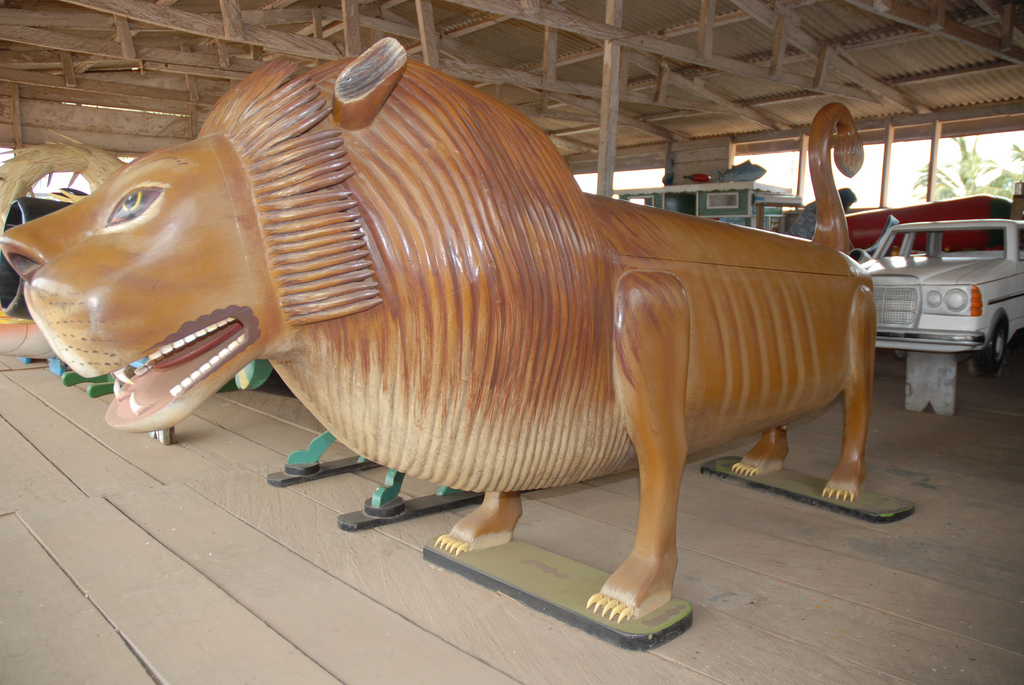
A look inside the world of Ghanaian fantasy coffins
By Isabelle Savoie
[hr]
Accra, 2015
[dropcap]Y[/dropcap]ou put on a dress and head out the door, knowing that hours of celebration lie ahead of you. This is going to be the celebration of the year — or so you’ve been told. As you approach the venue, you see people lining up to get in. It seems you were told correctly. He was a chief, after all.
In Ghana, “the most significant cost you’re going to incur in your life is not going to be your wedding,” said Barnard anthropology professor Brian Larkin, in an interview for the New York Times. “It’s going to be your funeral.”
Ghanaian funerals are not only a time for mourning. Of course, there is time for mourners to cry and give their final regards. There is often a traditional Christian funeral service. But there is another side to Ghanaian funerals, which may more fittingly be referred to as celebrations of life. It is not uncommon for billboards inviting “all those who sympathise” to attend, whether they knew the deceased personally or not. Coffins may be made in various shapes to represent the deceased as they were in life.
***
Teshie, 1950s
[dropcap]T[/dropcap]he town of Teshie lies near the Kotoka airport. A woman living there often expressed her awe and interest in the airplanes overhead. She wished to take advantage of this revolutionary mode of transportation. Unfortunately, she passed away before she had the chance.
Kane Kwei’s first fantasy coffin commission was one in the shape of an airplane for his grandmother, the woman who so longed to fly. Word of his work got around, and soon enough farmers and fishermen began inquiring if they could get similar coffins in the shape of things they felt represented them. And so, in the 1950s, Kane Kwei founded his fantasy coffin, or abebuam adeka, workshop in Teshie — a small suburb of Accra. This term in the language of the Ga tribe literally means “proverbial coffin.” These fantasy coffins serve as representations of things the deceased enjoyed or things that would have represented them well: a lion for a chief, a fish for a fisherman, or an airplane for a wealthy businessman. Since the earliest days of the family business, demand has continued to grow. Today, his grandson, Eric Adjetey Anang, is in charge of operations. He has built coffins in shapes of everything from cows to fish to cars.
Over the phone, he tells me the story of one of the most memorable coffins he has ever made. “Eric, the coffin this man’s children had bought for him has been rejected,” said a chief who came to him. “This is not really my place, but I will pay you double if you can make me a special coffin within the week.” With minimal time, and a request for a challenging shape he had never before had to construct, he set to work on a stingray — over 6 feet tall and more than 1 foot deep.
Aside from the coffins he makes for their traditional use, he has also received commissions from galleries all around the world, including the Seattle Art Museum, the National Museum of Funeral History in Houston, and the Museum of Death in St. Petersburg, Russia. As part of his current artist-in-residency at the University of Wisconsin, he will be building a coffin in the shape of a gun. Although this coffin will not symbolize any specific person who has died, it is intended to send a message against toxic gun culture in the United States.
***
Accra, 2015
[dropcap]A[/dropcap]s you make your way inside, people file in behind you and begin to spill out into the street. A larger-than-life lion surveys the room. Among the mourners, the dancers and those who have come merely to pay their respects, the lion commands the room’s attention. And you can’t help but think how fitting it is that in death this chief remains the same as he was in life.
[hr]
Isabelle Savoie is a junior Global Affairs major in Davenport College. Contact her at isabelle.savoie@yale.edu.